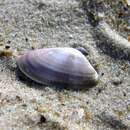en
names in breadcrumbs


Donax is a genus of small, edible saltwater clams, marine bivalve molluscs. The genus is sometimes known as bean clams or wedge shells; however, Donax species have numerous different common names in different parts of the world. In the southeastern U.S. they are known as "coquina", a word that is also used for the hard limestone concretions of their shells and those of other marine organisms.
Species of Donax live, sometimes in high concentrations, vertically aligned in the sand on exposed beaches, on tropical and temperate coasts worldwide. When the waves wash these small clams out of the sand, they can dig back in again quite rapidly. They are filter feeders. Some species, such as Donax variabilis, migrate vertically and horizontally with changes in the tides. These coquina clams are found extensively on the east coast beaches of Trinidad (Mayaro) and widely available in Venezuela. They are called "Chip Chip" in Trinidad & Tobago and "Chipi Chipi" in Venezuela.

Species within the genus Donax include:
The empty small (15 to 25 mm) shells of Donax variabilis and Donax fossor may be found washed up on the beach, especially at low tide. The living animals can often be seen where the waves wash the sand around in the shallowest part of the littoral zone as the tidal level changes. These clams can use the action of waves to move themselves up and down the beach, quickly burrowing into a new location before they can be swept away (the so-called "dance of the coquina").
Donax is a genus of small, edible saltwater clams, marine bivalve molluscs. The genus is sometimes known as bean clams or wedge shells; however, Donax species have numerous different common names in different parts of the world. In the southeastern U.S. they are known as "coquina", a word that is also used for the hard limestone concretions of their shells and those of other marine organisms.